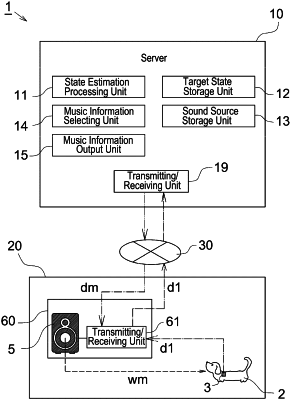| CPC A01K 15/021 (2013.01) [A01K 29/005 (2013.01); G06F 3/165 (2013.01); G06V 40/20 (2022.01); H04R 3/00 (2013.01); H04R 2420/07 (2013.01)] | 10 Claims |

|
1. A music providing system for a non-human animal, comprising:
a state information acquisition unit that acquires state information relating to a motion state of a target animal that is a non-human animal;
a state estimation processor that estimates, from the state information, a current behavioral state that is a behavioral state of the target animal at a current moment by arithmetic processing;
a target state storage that stores information relating to a target behavioral state that is a behavioral state aimed to be achieved of the target animal;
a sound source storage that stores a plurality of pieces of music information;
a music information selector that detects a degree of divergence of the current behavioral state from the target behavioral state by arithmetic processing, and selects a piece of specific music information based on the plurality of pieces of music information stored in the sound source storage by arithmetic processing; and
a music information output unit that outputs the specific music information to a speaker provided within a region where the target animal is present via wireless or wired communication,
wherein the music information selector carries out a process of selecting a different piece of the specific music information until the degree of divergence becomes equal to or less than a predetermined first threshold.
|